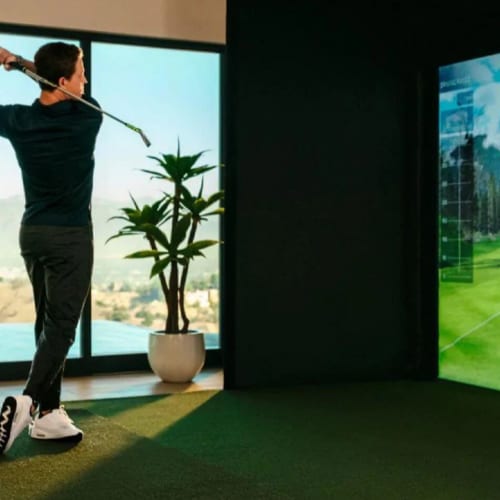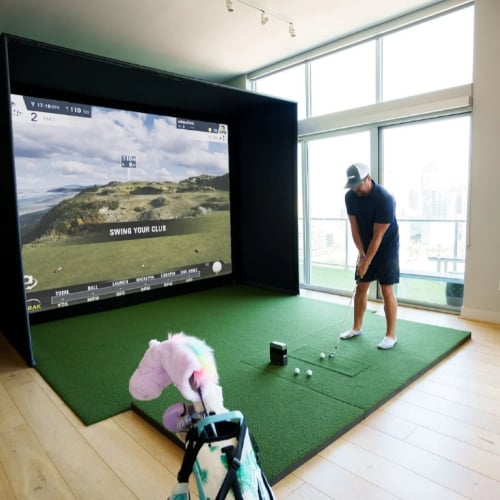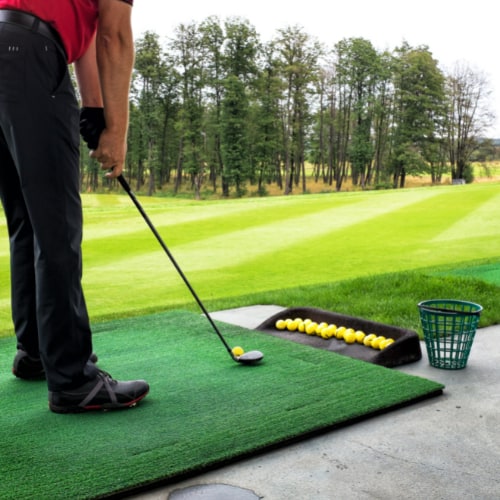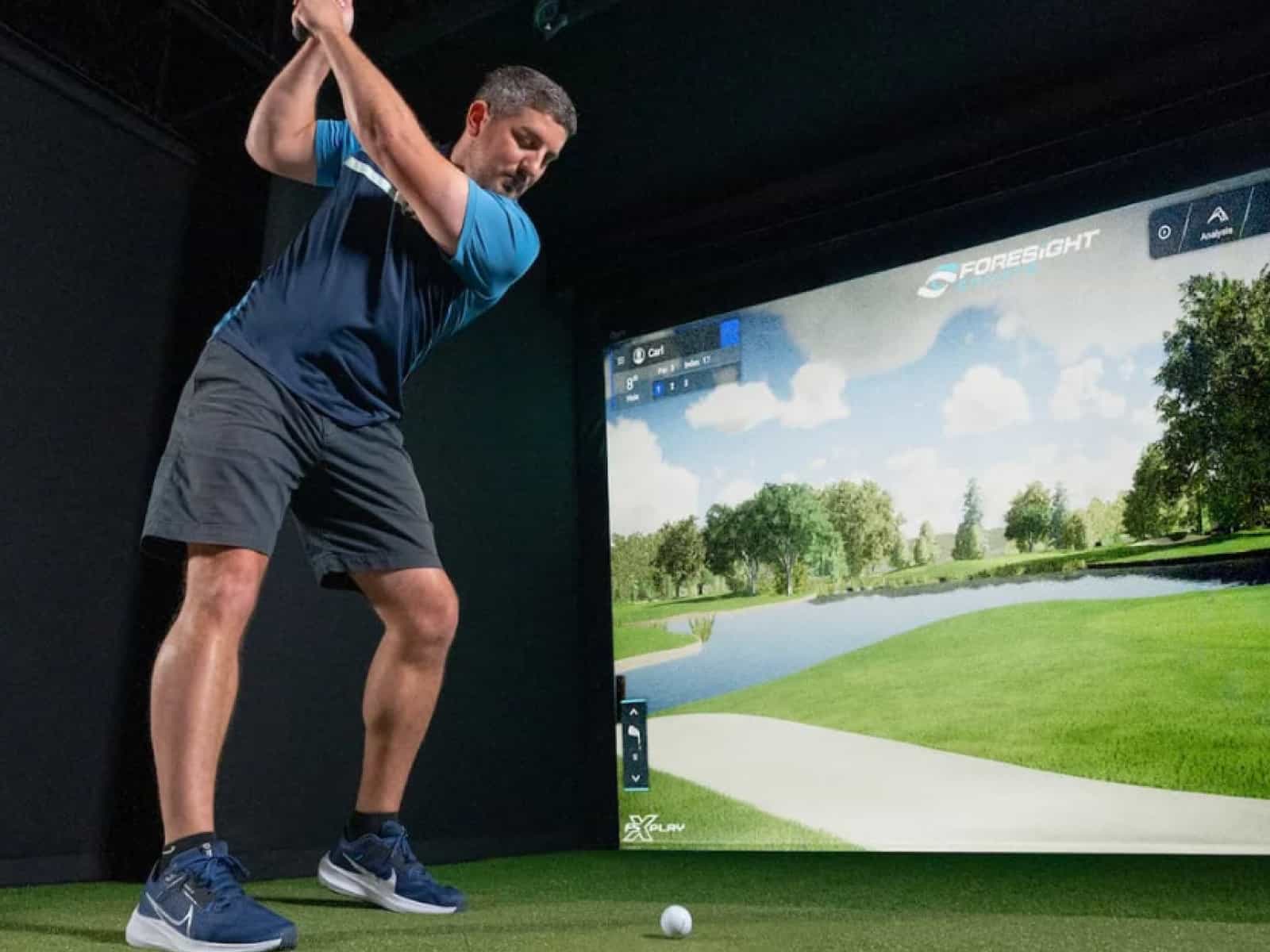Golf has long been a favored pastime for many people. It offers a great way to relax and have some outdoor fun. However, due to time constraints or bad weather, it’s not always possible to get outside for a round of golf. That’s why more and more people are turning to golf simulators as an alternative to the traditional driving range or golf course experience.
Comparing practicing on a golf simulator versus at a driving range can be tricky because they both offer unique benefits that cater to different types of players.
In this article we’ll take an in-depth look at each option, discussing the pros and cons of each and helping you determine which is right for you.
Keep reading for the ultimate comparison!
The Pros
Both options have their unique advantages, and it ultimately comes down to personal preference. Below are the advantages of golf simulators and driving ranges:
Practicing on A Golf Simulator – Advantages

- Accurate data collection for improved game: Golf simulators provide detailed data on ball speed, launch angle, swing path, club head speed, and more. With this instant feedback, you can identify areas of improvement and make adjustments to your swing and technique.
- Virtual course variety: Golf simulators offer the opportunity to play virtually on hundreds of golf courses worldwide, including famous courses like Pebble Beach and Torrey Pines.
- Immersive Experience: Some of the best golf simulators offer an immersive experience that goes beyond just golf shots. Many simulators offer immersive and realistic virtual golf courses with adjustable weather and turf conditions like wind, humidity, slope, green speeds, etc. They also use hitting mats with a real-life-like feel and high-fidelity and quality graphics that provide a realistic and engaging golf experience. You feel like playing on the actual course.
- Skill development: Simulators can simulate various shot scenarios, including tee shots, fairway shots, and approach shots. Golfers can practice specific aspects of their game, such as shot shaping or working on distance control, in a controlled and repeatable environment.
- A calm environment to focus on your game: If you are using a personal indoor golf sim, you can practice alone or with a limited number of friends or family members. The place will be much quieter than a crowded range, allowing for better focus on improving your game.
- No time commitment: You can play on your sim whenever you feel like it, and whenever you do it, you’re not obliged to finish a round (as on a real golf course). You can start practicing and stop whenever you want to.
- Entertainment value: Golf simulators can be an enjoyable and social experience, allowing you to compete with friends or participate in virtual tournaments. They often include additional features like virtual driving ranges, mini-games, and multiplayer options, adding entertainment value to the practice sessions.
Practicing on A Driving Range – Advantages

- More practice time: Driving ranges offer unlimited practice time, allowing golfers to hit as many balls as they want for as long as they need to perfect their swing for really low fees.
- Affordability: Driving ranges are usually more affordable than golf simulators, making them accessible for golfers on a budget. Bucket prices can range between $2 and $15, depending on many factors.
- Accessibility: Driving ranges are often publicly accessible and can be found in many areas. However, the quality of the range can vary depending on its location and management.
- Time-efficiency: Using a driving range allows you to focus solely on your driving skills without the time commitment of playing a full round. It provides a concentrated practice session that can be completed relatively quickly.
The Cons
While both golf sims and driving ranges can be great for improving your golf game, they both have their limitations and drawbacks. Here are some cons to consider before you decide which option is right for you.
Practicing On Golf Simulators – Drawbacks

- Limited Realism: While golf simulators are built to replicate a real golf experience, they cannot fully capture the feel of playing on a golf course due to the lack of real-world variables such as wind, weather, and course terrain.
- Cost: A good golf simulator setup can be expensive, especially if you want the latest hardware and software. Additionally, installing the equipment and setting up the space required can require considerable time and effort.
- Limited Space: Unless you have a large indoor area, you may not be able to set up a golf simulator in your home. This means that you may need to go to an indoor golf facility to access a simulator.
- Not Ideal for Developing Physical Skills: Golf simulators can help you develop your swing and general knowledge of the game, but they don’t provide the same physical workout as the actual course experience.
- High initial investment: To get a personal golf sim, you will need to make a substantial investment, especially if you opt for a premium setup that costs in the five-figure range.
Practicing On Driving Range – Drawbacks

- Limited Feedback: If you don’t have a coach or someone to give you feedback on your swing (or a launch monitor), you may not derive maximum benefits from practicing at a driving range. Without specific and detailed feedback, you may not be able to identify and correct mistakes.
- Limited practice elements: While driving ranges are great for working on driving skills, they lack the variety of shots and scenarios found on a golf course. You may miss out on practicing other aspects of your game, such as chipping, putting, and dealing with various lies.
- Weather Dependency: Practicing at a driving range is highly dependent on weather conditions. If it’s too windy or rainy, you may have to skip your practice session.
- Limited Variety: At a driving range, you are typically limited to hitting golf balls into an open field without any obstacles or target zones. This limits the range of skills that you can develop through practice.
- Limitations of Equipment: Hitting balls at ranges can wear out and damage your golf clubs, especially after prolonged use. Additionally, driving ranges may not have high-quality practice balls, which may affect the accuracy of your practice.
- Crowded or noisy- Not great for concentration: Popular driving ranges can become crowded, particularly during peak hours or weekends. This may result in limited space to practice, longer wait times, and a potentially noisy environment, which can affect concentration and focus.
- Long-term cost: Although driving ranges are generally more affordable than playing a full round of golf, the cost of range visits can add up over time, especially for frequent visitors.
The Bottom Line
When choosing between driving ranges and golf simulators, it’s important to identify the type of practice you are looking to get. If the goal is to work on ball striking and direction, then a driving range may be the best option. But if the goal is to get detailed feedback and an immersive experience, then a golf simulator may be the better choice.
Ultimately, the choice comes down to a balance between variety and targeted feedback. While a driving range provides a more or less authentic outdoor experience, a simulator can offer immediate and detailed feedback on various aspects of the swing (but costs much more than hitting the range).
Therefore, it is essential to weigh up the pros and cons and consider various factors such as budget, convenience, and preference, before making a decision.
Conclusion
Ultimately, choosing between a golf simulator and a driving range is a matter of personal preference. Both options have their pros and cons, and what works best for you will depend on your goals and budget.
If you value convenience and a more immersive experience and have a higher budget, a golf simulator will be the better choice. However, if you do not have the budget to invest in a virtual golf system, the driving range may be your best bet.
Thanks for reading!




